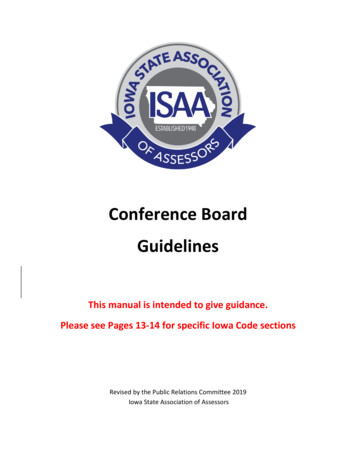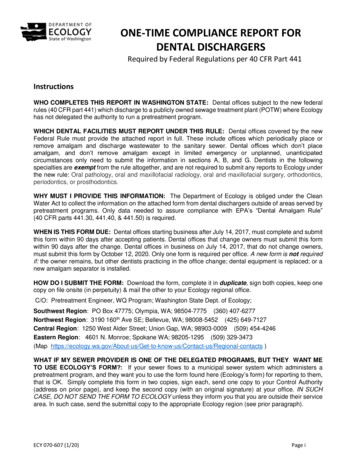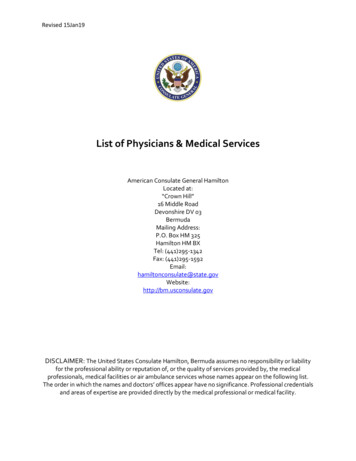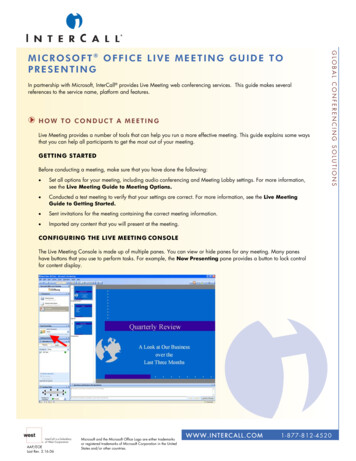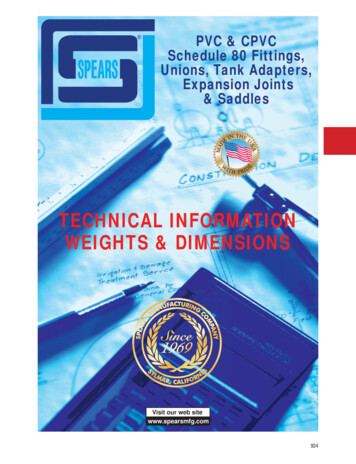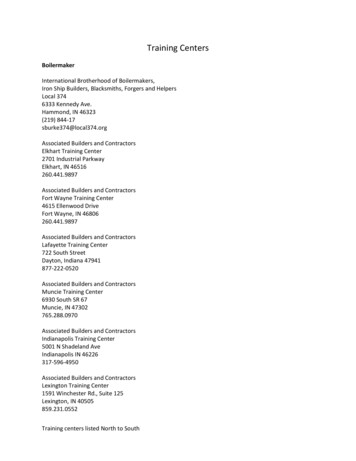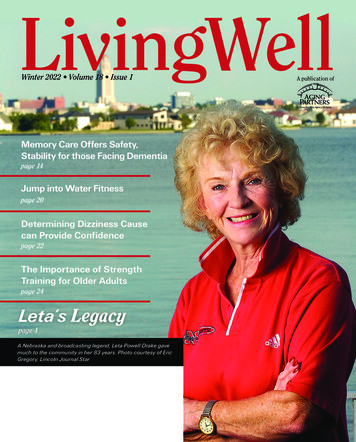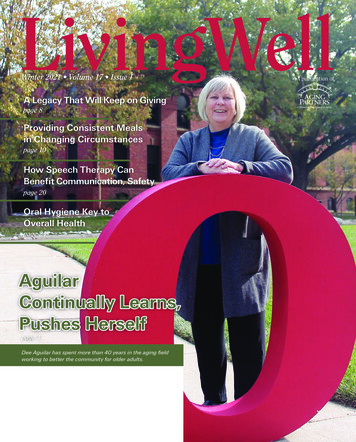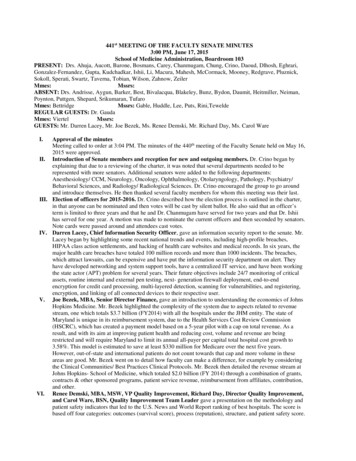
Transcription
441st MEETING OF THE FACULTY SENATE MINUTES3:00 PM, June 17, 2015School of Medicine Administration, Boardroom 103PRESENT: Drs. Ahuja, Aucott, Barone, Bosmans, Carey, Chanmugam, Chung, Crino, Daoud, Dlhosh, Eghrari,Gonzalez-Fernandez, Gupta, Kudchadkar, Ishii, Li, Macura, Mahesh, McCormack, Mooney, Redgrave, Pluznick,Sokoll, Sperati, Swartz, Taverna, Tobian, Wilson, Zahnow, ZeilerMmes:Mssrs:ABSENT: Drs. Andrisse, Aygun, Barker, Best, Bivalacqua, Blakeley, Bunz, Bydon, Daumit, Heitmiller, Neiman,Poynton, Puttgen, Shepard, Srikumaran, TufaroMmes: BettridgeMssrs: Gable, Huddle, Lee, Puts, Rini,TeweldeREGULAR GUESTS: Dr. GaudaMmes: ViertelMssrs:GUESTS: Mr. Darren Lacey, Mr. Joe Bezek, Ms. Renee Demski, Mr. Richard Day, Ms. Carol WareI.Approval of the minutesMeeting called to order at 3:04 PM. The minutes of the 440th meeting of the Faculty Senate held on May 16,2015 were approved.II. Introduction of Senate members and reception for new and outgoing members. Dr. Crino began byexplaining that due to a reviewing of the charter, it was noted that several departments needed to berepresented with more senators. Additional senators were added to the following departments:Anesthesiology/ CCM, Neurology, Oncology, Ophthalmology, Otolaryngology, Pathology, Psychiatry/Behavioral Sciences, and Radiology/ Radiological Sciences. Dr. Crino encouraged the group to go aroundand introduce themselves. He then thanked several faculty members for whom this meeting was their last.III. Election of officers for 2015-2016. Dr. Crino described how the election process is outlined in the charter,in that anyone can be nominated and then votes will be cast by silent ballot. He also said that an officer’sterm is limited to three years and that he and Dr. Chanmugam have served for two years and that Dr. Ishiihas served for one year. A motion was made to nominate the current officers and then seconded by senators.Note cards were passed around and attendees cast votes.IV. Darren Lacey, Chief Information Security Officer, gave an information security report to the senate. Mr.Lacey began by highlighting some recent national trends and events, including high-profile breaches,HIPAA class action settlements, and hacking of health care websites and medical records. In six years, themajor health care breaches have totaled 100 million records and more than 1000 incidents. The breaches,which attract lawsuits, can be expensive and have put the information security department on alert. Theyhave developed networking and system support tools, have a centralized IT service, and have been workingthe state actor (APT) problem for several years. Their future objectives include 24/7 monitoring of criticalassets, routine internal and external pen testing, next- generation firewall deployment, end-to-endencryption for credit card processing, multi-layered detection, scanning for vulnerabilities, and registering,encryption, and linking of all connected devices to their respective user.V. Joe Bezek, MBA, Senior Director Finance, gave an introduction to understanding the economics of JohnsHopkins Medicine. Mr. Bezek highlighted the complexity of the system due to aspects related to revenuestream, one which totals 3.7 billion (FY2014) with all the hospitals under the JHM entity. The state ofMaryland is unique in its reimbursement system, due to the Health Services Cost Review Commission(HSCRC), which has created a payment model based on a 5-year pilot with a cap on total revenue. As aresult, and with its aim at improving patient health and reducing cost, volume and revenue are beingrestricted and will require Maryland to limit its annual all-payer per capital total hospital cost growth to3.58%. This model is estimated to save at least 330 million for Medicare over the next five years.However, out-of-state and international patients do not count towards that cap and more volume in theseareas are good. Mr. Bezek went on to detail how faculty can make a difference, for example by consideringthe Clinical Communities/ Best Practices Clinical Protocols. Mr. Bezek then detailed the revenue stream atJohns Hopkins- School of Medicine, which totaled 2.0 billion (FY 2014) through a combination of grants,contracts & other sponsored programs, patient service revenue, reimbursement from affiliates, contribution,and other.VI. Renee Demski, MBA, MSW, VP Quality Improvement, Richard Day, Director Quality Improvement,and Carol Ware, BSN, Quality Improvement Team Leader gave a presentation on the methodology andpatient safety indicators that led to the U.S. News and World Report ranking of best hospitals. The score isbased off four categories: outcomes (survival score), process (reputation), structure, and patient safety score.
The upcoming changes to the 2015 Best Hospital Rankings include an addition of a “Common CareRating”, which will be the first set of ratings used to measure and publically report hospital performance ofcommon procedures and diagnoses. By 2016, hospitals will be placed into tiers (high performing vs.average vs. below average) for 19 different procedures and diseases. Some of this data has already beenreleased for diseases such as COPD and CHF and procedures such as hip and knee replacements. Twentyone ratings for five Hopkins-affiliated hospitals were given, 4 of which were classified as “highperforming”, 10 of which were “average”, and 7 of which were “below average”. The patient safetyindicators (PSI), which contribute to 10% of the overall rating, were detailed and include death in lowmortality diagnosis-related groups, pressure ulcer, foreign body left in during procedure, postoperativesepsis, etc. Several methods for improving the ranking of Johns Hopkins were outlined, which included aneed for physicians to respond to queries in a timely manner and hints for improved documentation. Thesesuggestions for change will take time, likely several years, to make a difference in the USNWR rankings.Data and rankings will be out in July.The results of the election were announced. Dr. Crino, Dr. Chanmugam, and Dr. Ishii were re-electedunanimously. Finally, Dr. Crino encouraged everyone to check the website for two changed dates (September2015 and May 2016). He then thanked everyone for coming and adjourned the meeting at 5:05 PM.Respectfully submitted,Masaru Ishii, MD, PhDRecording Secretary
Information Security ReportJohns Hopkins MedicineFaculty SenateDarren Lacey (dll@jhu.edu)June 17, 2015
National Trends and Events 2014 saw aggressive attacks, focusedon known (and unknown)vulnerabilities (e.g. Heartbleed) High-profile breaches continued infinance and retail Continued rapid increase in the speedand danger of malware proliferationand changes in the hacker blackmarket Increase in highly disruptive breaches(e.g. Sony) HIPAA class action settlements Stanford: 4.1 million for 20K recordsposted on Web AvMed: 3 million for 1 million recordson lost laptop HIPAA federal settlement atColumbia/NYP for 4.3 million for 7Krecords posted on Web CHS notified 4.5 million from foreignhacker penetration and exfiltration Anthem Healthcare experiencedhacking attackof potentially 80 million records inJanuary 2015 CareFirst website hack in April 20152
Timeline of Major Healthcare BreachesBCBS Tennessee1.02MStolen Hard DrivesTRICARE4.9MLost BackupsNYC Health & Hospitals1.7MStolen Backup Tapes2009AvMed1.2MStolen Laptops2010Health Net1.9MLost Hard Drives2012Emory315KLost BackupsNemours1.6MLost BackupsCommunity Health4.5MHackingUPMC27-62KHackingUtah Dept. of Health780KHacking2011Source: Privacy Rights te Medical4.03MComputer Theft20132014Horizon BCBS840KLaptop Theft6 Yea Totals: 100M Records 1000 IncidentsNote the shiftfrom physicalloss to hackingAnthem BCBS80MHackingMontana Public Health1.3MHacking3
Healthcare Risk Breaches could be expensive Medium-sized breaches ( 10K records) typically attract lawsuits and/orenforcement actions in the 2-10 million range CHS is one of the first health systems of this generation of large breaches;final costs not yet known (at 25/record it could exceed 100 million) Anthem breach should help set the price Impact on cyber-liability market not yet known HIPAA Cops -- Office of Civil Rights (OCR) audits becoming morefrequent and more proactive State actors seem to be gathering PII for purposes other thancybercrime4
Different Security “Models”Regulated Entity (e.g. finance, government)UsLimited # of critical assets & PIIUbiquitous PHIClinical segmented from academicControlled Web presenceFlat network800 web servers, 1,700 domainsManaged devices are the rule½ of our network devices are ‘unmanaged’Directory is mainly professional staffDirectory includes 150KCentralized analytics teamsSeveral dozen operational reporting teamsFew supervisory and control systems 5000 medical devicesTechnology MonocultureNoah’s Ark
Some advantages over our peers Unlike others, we have been working the state actor (APT) problem for severalyears We have a solid networking and system support tools and program in place We are more centralized in IT services than other research universities and evenmore than some academic medical centers Epic deployment has triggered strong institutional response to risk Enterprise Risk Management Program Data Privacy Protection Program (DP3) Data Trust Initiative While our investment in security has been traditionally low, there has been arecent increase Network segmentation will use current technologies and is not hostage to arcanelegacy tools
Three Year ObjectivesAll connected devices are registered,encrypted, & linked to userNetwork segmentation is handled inboth directionsInternet visible hosts are routinelyscanned for vulnerabilitiesEvery PHI application is assessed forriskRoutine internal and external pentestingMulti-layered detectionNo critical asset accessed withpassword alone24/7 monitoring of critical assetsUser access monitoring is deployedfor clinical applicationsPrivacy protection is supported (e.g.Data Trust, DP3)
Likely impact on the JHM communityDigital CognoscentiUsersBuilding and managing awebsite/application or mobile app will beharderMore paperwork (e.g. risk assessments,remediation plans) for funded projectsRamped up logging and monitoringMulti-factor authentication will beubiquitous and it will mature faster insome areas than othersReliance on virtual desktops willincreaseBYOD agentsRoutine vulnerability scanning will berequiredCloud options will require cryptoMonitoring will likely generate oddrequests from monitoring groupsMore restrictions on desktopsSystems will fail ‘closed’IT support will become more complex
Plans for 2016-17 Complete next-generation firewalldeployment Deploy device securityinterrogation on wireless and VPN Consolidate host controls such asapplication whitelisting andmemory corruption Begin implementation of hostand/or network data leakprevention Build internal capabilities forpenetration testing Submit a plan for 24/7 securityoperations center coverage Complete JHM applicationinventory and remediation plan forprimary systems, and analyticsengines Deploy end-to-end encryption forcredit card processing Complete JHM desktop encryptionproject Publish tools for research supportin de-identification9
JOHNS HOPKINS UNIVERSITYSCHOOL OF MEDICINEFaculty SenateIntroduction to Understanding theEconomics of Johns Hopkins MedicineJune 17, 2015
September 18, 20152
Johns Hopkins Medicine (JHM) A “virtual” entity with many member organizations Finances: High level of complexity primarily due to aspects related tothe revenue stream Not uncommon to healthcare industry, unlike other industries Buying a book at Barnes & Nobel versus a hip replacementa) Select book and pay at the registerb) Provide patient service, document (including use of Epic systemand capturing quality metrics), select a CPT code, submit bill in aformat as dictated by different Payers, bill again for patientportion (confused patients), follow-up on denials, receivedifferent payment from different Payers for the same service To compound things, many changes are now taking place in thehealthcare industrySeptember 18, 20153
JHM – High Level Johns Hopkins University – School of Medicine Johns Hopkins Health System Hospitals1.2.3.4.5.6.7.Johns Hopkins Hospital (Academic Division)Johns Hopkins Bayview Medical Center (Academic Division)Howard County Hospital (Community Division)Suburban General Hospital (Community Division)Sibley Memorial Hospital (Community Division)All Childrens Hospital (ACH)Johns Hopkins Community Physicians (JHCP) Johns Hopkins Health Care1. Priority Partners (Medicaid Managed Care Organization)2. Employee Health Program (Hopkins based health insurance plan)3. United States Federal Health Plan (Military & families insurance plan) Johns Hopkins InternationalSeptember 18, 20154
JHM Finances – Revenue StreamHospitals: 3.7 Billion1. Reimbursement system is NOT like the rest of the US (excludingACH)2. State of Maryland, via the Health Services Cost ReviewCommission (HSCRC) (www.hscrc.state.md.us), has a uniquepayment model3. Previously, methodology provided similar payments for similarservices (included a waiver from the national Medicare hospitalpayment system), more volume was good4. Currently, a new Global Budget Revenue (GBR) model based on a5-year pilot with a cap on total revenue, resulting in volume /revenue being restrictedSeptember 18, 20155
JHM Finances – Revenue StreamJohns Hopkins University – School of Medicine : 2.0 Billion Revenue stream is similar to the rest of US and other AcademicMedical Centers Patient Clinical Services Research / Sponsored Projects Education Internal funding sources (Joint Agreement & SOM) Fund raisingSeptember 18, 20156
JHM Finances – Revenue StreamHospitals: 3.7 Billion (FY 2014)1. Maryland's All-Payer Model Agreement was approved by theCenters for Medicare & Medicaid Services (CMS) on January 10,20142. “Aimed at improving patient health and reducing costs.”3. This initiative will replace Maryland’s 36-year-old Medicarewaiver to allow the state to adopt new policies that reduce percapita hospital expenditures and improve health outcomes asencouraged by the Affordable Care Act.4. Under this model, Medicare is estimated to save at least 330million over the next five years.5. This model will require Maryland to limit its annual all-payer percapita total hospital cost growth to 3.58%.September 18, 20157
JHM Finances – Revenue StreamHospitals: 3.7 Billion (FY 2014) Global Budget Revenue (GBR) Agreements1. Each hospital has their own GBR that ties into the overall 3.58%growth rate2. Revenue / volume in excess of the GBR agreement is not good3. JHH and JHBMC has a GBR growth rate exceptions for Out-OfState and International patients, more volume in these areas isgoodSeptember 18, 20158
JHM Finances – Revenue StreamHospitals: 3.7 Billion Opportunities – How you can make a difference1. Focus on cost reductions initiatives2. Supply Chain / Purchasing3. Gainsharing example from New Jersey (article)4. Clinical Communities / Best Practices Clinical Protocols (Lisa Ishii,MD) resulting in improvements in care5. Lower cost per unit (patient service) will improve profitability6. Quality measures: Readmission and Hospital Acquired Conditionscan both decrease or increase the cost of care in addition to avoidor cause HSCRC penaltiesSeptember 18, 20159
JHM Finances – Revenue StreamHospitals: 3.7 BillionSeptember 18, 201510
JHM Finances – Revenue StreamJohns Hopkins University – School of Medicine: 2.0 Billion(FY2014)1. Grants, Contracts & Other Sponsored Programs @ 693 million(34%)2. Patient Service Revenue @ 639 million (31%)3. Reimbursement from Affiliates @ 409 million (20%)4. Contributions @ 113 million (6%)5. Other @ 188 million (9%)September 18, 201511
JHM Finances – Revenue StreamJohns Hopkins University – School of Medicine: 2.0 Billion(FY2014)Grants, Contracts & Other Sponsored Programs @ 693 million (34%)1. Significant part of the Hopkins Mission2. Challenges:a) NIH budget reductionsb) NIH salary cap @ 181,500c) reductions in indirect cost recoveries3. Opportunities:a) Discovery / patentsb) Diversification of research portfolio (industry, foundations,Biotech)September 18, 201512
JHM Finances – Revenue StreamJohns Hopkins University – School of Medicine: 2.0 Billion(FY2014)Patient Service Revenue @ 639 million (31%)1. Significant part of the Hopkins Mission2. Represents major source of cross-subsidy for other SOM missions andprograms, only service line that generates a profit (or loss)3. Payer Mixa) 41% of payments are dictated (Medicare and Medicaid)b) 49% of payments negotiated (BlueShield / CareFirst, UnitedHealthcare, Aetna, Cigna, etc.)c) 5% Self Payd) 5% Other (including International)September 18, 201513
JHM Finances – Revenue StreamJohns Hopkins University – School of Medicine: 2.0 Billion(FY2014)Patient Service Revenue @ 639 million (31%)Challengesa) Medicare Fee-For-Service payment SGR formula has been eliminated, 0.5% annualincreases through 2019 with future payments being influence by quality metricsb) CPT code realignment (e.g., 2015 reductions in Ophthalmology and Radiology)c) Medicaid payment reductions due to state budget issues (e.g., E&M codes from100% of Medicare rates to 92%)d) Bending the cost curve, Medicare Accountable Care Organizations based on “riskarrangements” resulting in overall payments being lowere) ICD-10 implementation October 2015, Payer readinessf) Epic Professional Fee billing system implementation December 2015, cash lagg) Medicare payments tied to quality reporting and related scoresh) Non-governmental Payers following Medicare’s lead also, narrow networksSeptember 18, 201514
JHM Finances – Revenue StreamJohns Hopkins University – School of Medicine: 2.0 Billion(FY2014)Patient Service Revenue @ 639 million (31%)Opportunitiesa) Improve the patient experienceb) Reduce clinic cancellationsc) Increase patient access via Access Services scheduling (e.g., directscheduling via Epic myChart)d) Meaningful Use quality measures (e.g., After Visit Summary, etc.)e) Productivity improvementsf) Close Epic encounters in a timely fashion so bills can be processedg) Population Health via Accountable Care Organization (e.g., best practices/ clinical protocols and cost efficiencies)September 18, 201515
JHM Finances – Revenue StreamJohns Hopkins University – School of Medicine: 2.0 Billion(FY2014)Reimbursement from Affiliates @ 409 million (20%)1. Primarily from JHH and JHBMC for services rendered2. Challenge: Hospital will find it more difficult, but not impossible, toprovide future funding due to the new HSCRC GBR constraints3. Opportunity: Partner with Hospitals on initiatives noted above (e.g.,International & Out-Of-State patients, Gainsharing / Cost reduction, etc.)September 18, 201516
JHM Finances – Revenue StreamJohns Hopkins University – School of Medicine: 2.0 Billion(FY2014)Contributions @ 113 million (6%)1. Hopkins has been very fortunate2. Philanthropy subject to the economy3. Endowment income subject to marketSeptember 18, 201517
JHM Finances – Revenue StreamJohns Hopkins University – School of Medicine: 2.0 Billion(FY2014)September 18, 201518
JHM Finances – Expense SummarySeptember 18, 201519
Thank youQuestionsSeptember 18, 201520
U.S. News & World ReportRenee Demski, VP Quality, JHHS, Armstrong InstituteSean Evans, Director MarketingJune 2, 2015JHM Marketing and Communications
Agenda 2014 Best Hospitals Methodology Review Proposed Changes to 2015 Best Hospitals An Introduction to Common Care Ratings QuestionsJHM Marketing and Communications
2014 Best Hospitals MethodologyJHM Marketing and Communications
Best Hospitals Methodology Outcomes (Survival score) (32.5%) Process (Reputation) (27.5%) Structure (30%) Patient Safety Score (10%)
Best Hospitals Methodology Outcomes–– Process (Reputation)–– Two samples of survey – AMA physician list (1,600 total) and Doximity (members: 50K;nonmembers: 2,400).Average of 2012, 2013, and 2014 responses.Structure–– Source: Inpatient Medicare Data for 2010, 2011, and 2012.Compares the number of Medicare inpatients who died within 30 days of admission with thenumber expected to die. Each specialty received a score of 1 (lowest) to 10 (highest).These include hospital volume, nurse staffing, technology, and other resources that define thehospital environment.Source: 2012 AHA Survey and MedPAR database.Patient Safety Score–Hospital-based score of 1 (lowest) to 5 (highest)
Upcoming Changes to the2015 Best Hospital RankingsJHM Marketing and Communications
2015 Best Hospital Changes USNWR uses MEDPAR administrative data– 3 prior Federal fiscal years (2011,2012, and 2013) Doximity– Sole source of information for the physician survey– Surveying members and non-members– Why this matters and potential impact Other Changes– Revisiting PSI’s currently used– Use of the CDC’s National Healthcare Safety Network’s(NHSN) infection dataJHM Marketing and Communications
Common Care Ratings What is it? What’s included in the rating? What’s being rated / How did the JHHS Hospitalsperform? How does the public view the rating? How does this compare to “Best Hospitals”?JHM Marketing and Communications
What is it? On May 20th, US News released its first set ofratings to measure and publically report hospitalperformance of common procedures anddiagnoses. Over 6,000 hospitals are included Additional procedure and disease ratings will bereleased in 2016, for a total of 19. This does not replace Best Hospitals Hospitals are not ranked, rather they are placedinto tiers as “high-performing”, “average”, orJHM Marketing and Communications“below average”.
What’s Included in the Rating? 2010, 2011, and 2012 2013 CMS HospitalIP Medicare DataCompare Data– Mortality– Readmissions: Samecause and all-cause– Event-free admissions– Volume 2013 HCAHPS 2013 AHA Survey– RN Staffing– Intensivist Staffing– HAIs Nurse Magnet Procedure / DiseaseSpecific Datasets– e.g., STS Database forCABG Reputation data is notusedJHM Marketing and Communications
What’s Being Rated? /How did JHHS do?Potential future disease/procedure ratings include: Pacemaker insertion,stroke, prostatectomy, spine fusion, mastectomy, hysterectomyJHM Marketing and Communications
How Does the Public View thisInformation? / What Do They See? Ratings for the 5 previous conditions are publically available on the US Newswebsite. Below is an example of what a consumer can view.JHM Marketing and Communications
How Does this Compare to“Best Hospitals”? What’s similar––––Inpatient onlyMedicare onlyAHA SurveyHospitals are allowed topurchase US Newsbadge to promoterating What’s different– No reputation included– No numerical ranking– HCAHPS and HospitalCompare used inCommon Care– Each condition has itsown components andweightingJHM Marketing and Communications
USNWR PSIRichard Day, Director Quality ImprovementCarol Ware, QI Team Leader, Special Projects
Agenda Define AHRQ PSIs Review USNWR Safety Methodology Discuss current performance results Describe “how you can help”
US News and World Reports(USNWR)Quality Indicators Patient Safety: 10% of overall score– Agency for Healthcare Research and Quality (AHRQ) 8 Patient SafetyIndicators(PSI): 5 point scale1. Death among surgical patients with serious treatable complications2. Iatrogenic pneumothorax3. Perioperative hemorrhage and hematoma4. Postoperative respiratory failure5. Postoperative wound dehiscence6. Accidental puncture or laceration7. Pressure ulcers (new)8. Postoperative hip fracture (new)Survival: 32.5% of overall score– Mortality– Score from 1 to 10 (the highest survival rates receive a score of 10)Based on MEDPAR administrative dataIncludes data for federal fiscal years (10/1-9/30) 2010, 2011,201216
What is AHRQ? Agency for Healthcare Quality and Research (AHRQ)Agency within the US Department of Health and Human Services (DHHS)AHRQ Mission:To improve quality, safety, efficiencyand effectiveness of healthcare forall Americans
AHRQ Quality Indicators*Patient tric QualityIndicatorsNeonatalPreventionQuality nditionsInpatient QualityIndicatorsMortalityUtilizationVolume
Methodology: AHRQ Quality Indicators Measure definitions are based on severaldata elements– ICD9 Diagnosis and procedure codes– MSDRG, MDC, sex, age, procedure date, admittype, source, D/C disposition, point of origin,POA– Numerator # of cases with outcome of interest(exp. Post-op sepsis)– Denominator population at risk (pneumoniapatients, elective surgery, population census
RevisionsEach year AHRQ updates the PSIs to reflectchanges made to: ICD9 Coding specifications Data elements in the Uniform Billing Form Other Technical Changes
AHRQ Patient Safety Indicators Death in low-mortality diagnosisrelated groupsPressure ulcerDeath among surgical inpatientswith treatable seriouscomplicationsForeign body left in duringprocedureIatrogenic pneumothoraxCentral venous catheter-relatedbloodstream infectionsBirth trauma—injury to neonateObstetric trauma—vaginal deliverywith instrumentObstetric trauma—vaginal deliverywithout instrument Postoperative hip fracturePostoperative hemorrhage orhematomaPostoperative physiologic andmetabolic derangementsPostoperative respiratory failurePostoperative pulmonary embolismor deep vein thrombosisPostoperative sepsisPostoperative wound dehiscenceAccidental puncture or lacerationTransfusion reaction21
Maryland Quality Based ReimbursementPSI90 Composite PSI #3 Pressure Ulcer Rate PSI #6 Iatrogenic PneumothoraxRate PSI #7 Central Venous CatheterRelated Blood Stream InfectionRate PSI #8 Postoperative HipFracture Rate PSI #9 Perioperative Hemorrhageor Hematoma Rate PSI #10 PostoperativePhysiologic and MetabolicDerangement Rate PSI #11 PostoperativeRespiratory Failure Rate PSI #12 PerioperativePulmonary Embolism or DeepVein Thrombosis Rate PSI #13 Postoperative SepsisRate PSI #14 Postoperative WoundDehiscence Rate PSI #15 Accidental Punctureor Laceration Rate22
Performance Impact1. Patient Care–goal is to eliminate harm2. Reputation––––Impact on US News and World Report(USNWR) rankingIncluded in USNWR routine care CY15University Health Consortium Quality and Accountability RankingConsumer Reports3. Revenue– Quality Based Reimbursement 2% total revenue at risk –Safety measure 35% FY17Value Based Purchasing Safety measure 20% FY17
What will it take to regain #1 ranking in USNWR safetyindicators Current overall score 1 # 1 overall score 5Based on Medicare cases only
USNWR Hospital Ranking and PSI ScoresRankingHospitalPSI Score#1Mayo Clinic5#2Massachusetts General4#3The Johns Hopkins Hospital1#4Cleveland Clinic3#5UCLA Medical Center4#6New York-Presbyterian University Hospital5#7Hospitals of the University of Pennsylvania5#8UCSF Medical Center5#9Brigham and Women’s Hospital4#10Northwestern Memorial Hospital425
Action Plan1.2.3.Activate 100% Medicare PSI retrospectivecase review– Rebilled overturned cases– Preliminary YTD FY 15 (10/14 -3/13/15)overturned 25% of reviewed casesImplemented Medicare Bill Hold Process: willimpact FY15 performance– 7/14 designed and implemented MedicareBill Hold process– 8/14 bill hold initiated for current 8 PSIs– 9/14 additional 8 PSIs added to bill hold– 10/14 installed AHRQ PSI filter thatincludes POA and exclusion criteria thatwill improve bill hold review efficiencyIdentified top volume and conducting drilldown to identify root cause (FY14 and FY15)–PSI09 Perioperative Hemorrhage andHematoma–PSI15 Accidental Puncture or Laceration4. Implemented improvements to the DocuCheckprovider query process – work is ongoing5. Implemented Computer Assisted Coding (CAC)in quality improvement6. Ultimate Best Practice – concurrent review andimprove documentation while patient is still aninpatient26
Medicare Bill Hold ProcessMedicare Bill Hold ProcessKey: QIS Quality Improvement Specialist, ACE coding validation contractor, PSI Patient Safety Indicator, MHAC Maryland Hospital AcquiredConditionHIM/FinancePhaseCoder codesthe MedicarerecordDid medicare casemeet the bill holdbased on AHRQPSI inclusioncriteriaYesNoCaseautomaticallyplaced on Keanebill hold for 7days from MRfinal codingapproval datePSI casereleased forbillingQISQISQIS sends theAHRQ PSI listdaily to ACEQIS reviews thecases receivedfrom the ACEreviewer andvalidates thePSI/MHACassignmentQIS disagreeswith the ACEPSI/MHACassignmentYesACEQIS runs a dailyAHRQ PSIreport fromCVIEW andsends to ACE forvalidationQIS reviewsKEANE bill holdsdailyAce performsvalidationreview of PSIsand MHACsAce sends thereviewed list ofPSIs and MHACsto QISAce performsfinal validationof QIS requestfor review ofPSIs and MHACsNOQIS performsreconciliationbetween AHRQPSI list and theKeane bill holdlistQIS releasescase for billingReleases anycase that doesnot appear onthe CviewAHRQ PSI list
UHC Medicare Federal Fiscal Year Performance Trend(2010 thru Preliminary FFY 2015 (Oct 2014- Feb 2015)UHC JHH FFY Medicare PSI ovement157Preliminary10/14-2/1561JHH 2010JHH 2011JHH 2012JHH 2013JHH 2014JHH 2015
UHC Medicare USNWR PSI ComparisonFederal Fiscal Year (Oct 1, 2013 – Sep 30, 2014)FFY 2014 Medicare PSIBAYVIEW53JHH157MASS GEN181CLEVELAND CLINIC237MAYO275050100150200250300
Preliminary UHC Medicare USNWR PSI ComparisonFederal Fiscal Year: (Oct 1, 2014 – Feb 28, 2015)Preliminary FFY2015 PSI ComparisonBAYVIEW23MASS GENERAL48JHH61CLEVELAND CLINIC72MAYO89020406080100
How can you help? Encourage department faculty meetings with CDE Me
Reliance on virtual desktops will increase. Ramped up logging and monitoring: BYOD agents. Routine vulnerability scanning will be required: Monitoring will likely generate odd requests from monitoring groups. Cloud options will require crypto: More restrictions on desktops. Systemswill fail 'closed' IT support will become more complex
